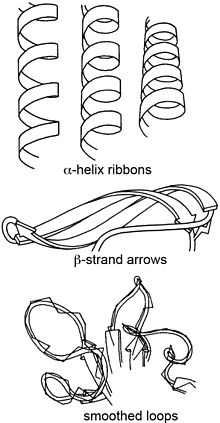Ribbon diagram

Ribbon diagrams, also known as Richardson diagrams, are
Ribbon diagrams are simple yet powerful, expressing the visual basics of a molecular structure (twist, fold and unfold). This method has successfully portrayed the overall organization of protein structures, reflecting their three-dimensional nature and allowing better understanding of these complex objects both by expert structural biologists and by other scientists, students,[2] and the general public.

History
The first ribbon diagrams, hand-drawn by
In 1982,
Since their inception, and continuing in the present, ribbon diagrams have been the single most common representation of protein structure and a common choice of cover image for a journal or textbook.
Current computer programs
One popular program used for drawing ribbon diagrams is
Features

| Secondary structure[4][5] | |
|---|---|
| α-Helices | Cylindrical spiral ribbons, with ribbon plane approximately following plane of peptides. |
| β-Strands | Arrows with thickness, about one-quarter as thick as they are wide, showing direction and twist of the strand from amino to carboxy end. β-sheets are seen as unified because neighboring strands twist in unison. |
| Loops and miscellaneous | |
| Nonrepetitive loops | Round ropes that are fatter in the foreground and thinner towards the back, following smoothed path of Cα trace. |
| Junctions between loops and helices | Round rope that gradually flattens out into a thin helical ribbon. |
| Other features | |
| Polypeptide direction,
NH2 and COOH termini |
Small arrows on one or both of the termini, or letters. For β-strands, the direction of the arrow is sufficient. Today, the direction of the polypeptide chain is often indicated by a colour ramp. |
| Disulfide bonds | Interlocked SS symbol or a zigzag, like a stylized lightning stroke. |
| Prosthetic groups or inhibitors | Stick figures, or ball & stick. |
| Metals | Spheres. |
| Shading and colour | Shading or colour adds dimensionality to the diagram. Generally, the features at the front are the highest in contrast and those towards the back are the lowest. |
See also
References
- ^ Smith, Thomas J. (October 27, 2005). "Displaying and Analyzing Atomic Structures on the Macintosh". Danforth Plant Science Center. Archived from the original on 28 March 2002.
- .
- ^ S2CID 52856546.
- ^ PMID 3853075.
- ^ PMID 7020376.
- ^ "Science's 'Mother of Ribbon Diagrams' celebrates 50 years at Duke". Duke Stories. 2018-10-19. Retrieved 2020-06-09.
- PMID 7071602.
- .
- PMID 1304880
- ^ MolScript v2.1: About the program
- PMID 19768809
- PMID 15766548.
- PMID 19956203.
